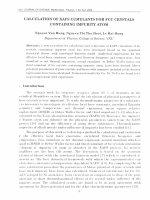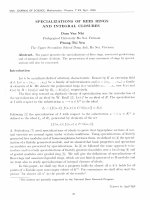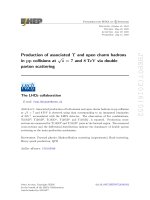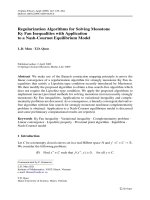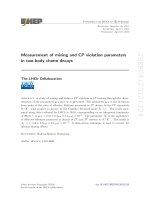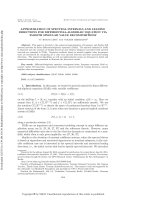DSpace at VNU: Calculation of Morse Potential Parameters of bcc Crystals and Application to Anharmonic Interatomic Effective Potential, Local Force Constant
Bạn đang xem bản rút gọn của tài liệu. Xem và tải ngay bản đầy đủ của tài liệu tại đây (137.52 KB, 8 trang )
VNU Journal of Science: Mathematics – Physics, Vol. 31, No. 3 (2015) 23-30
Calculation of Morse Potential Parameters of bcc Crystals and
Application to Anharmonic Interatomic Effective Potential,
Local Force Constant
Nguyen Van Hung1,*, Trinh Thi Hue1, Nguyen Ba Duc2
1
VNU University of Science, 334 Nguyen Trai, Thanh Xuan, Hanoi, Vietnam
2
Tan Trao University, Km6, Trung Mon, Yen Son, Tuyen Quang, Vietnam
Received 24 February 2015
Revised 28 April 2015; Accepted 15 July 2015
Abstract: In this work, Morse potential parameters of bcc crystals have been calculated based on
the calculation of volume per atom and atomic number in each elementary cell, as well as the
energy of sublimation, the compressibility and the lattice constant. They are used for studying the
anharmonic interatomic effective potential, local force constant in XAFS (X-ray Absorption Fine
Structure) theory. Numerical results for Fe, W and Mo are found to be in good agreement with
experiment and with those of other theories.
Keywords: Morse potential parameter, effective potential, local force constant, bcc crystals.
1. Introduction∗
Anharmonic interatomic potentials including Morse potential parameters [1,2], have been
intensively studied [1-17]. They are used for the calculation and analysis of the thermodynamic
parameters, especially, the anharmonic effects contained in XAFS (X-ray Absorption Fine Structure)
[10-15] which influence on the physical information taken from these spectra. Morse potential is an
empirical potential [1,2] and their parameters are often extracted from experiment [16,17]. Therefore,
calculation and analysis of Morse potential parameters are of great interest, especially in XAFS theory.
This work is a next step of our previous work [18] for the calculation and analysis of Morse
potential parameters of bcc crystals based on the calculation of volume per atom and atomic number in
each elementary cell. This calculation of atomic number is our further development compared to the
previous theory [18], and due to that the present method can be generalized to the calculation for the
other crystal structures. The energy of sublimation, the compressibility and the lattice constant used in
the present considerations are available [19-21]. The obtained Morse potential parameters are applied
_______
∗
Corresponding author. Tel.: 84-912686593
Email:
23
24
N.V. Hung et al. / VNU Journal of Science: Mathematics – Physics, Vol. 31, No. 3 (2015) 23-30
to the calculation and analysis of the anharmonic interatomic effective potential, local force constants
and anharmonic effects in XAFS theory. Numerical results for Fe, W and Mo are compared to
experiment [17] and to those of other theory [2] which show good agreement.
2. Formalism
2.1. Calculation of Morse potential parameters
Following [18] the potential energy ϕ (rij ) of two atoms i and j separated by a distance rij is given
in terms of the Morse function by
ϕ (rij ) = D e
− 2α
(rij − ro ) − 2e−α (rij − ro )
,
(1)
where α , D are constants with dimensions of reciprocal distance and energy, respectively; ro is the
equilibrium distance of the two atoms. Since ϕ (ro ) = − D , D is the dissociation energy.
In order to obtain the potential energy of the whole crystal whose atoms are at rest, it is necessary
to sum Eq. (1) over the entire crystal. This is most easily done by choosing one atom in the lattice as
an origin, calculating its interaction with all the others in the crystal, and then multiplying by N / 2 ,
where N is the total atomic number of the crystal. Thus, the total energy Φ is given by
Φ=
−α r j − ro
− 2α r j − ro
1
ND ∑ e
− 2e
.
2
j
(2)
Here r j is the distance from the origin to the jth atom. It is convenient to define the following
quantities
L=
1
ND ; β = eαro ; r j = m 2j + n 2j + l 2j
2
[
]
1/ 2
a = M ja ,
(3)
where m j , n j , l j are position coordinates of any atom in the lattice. Applying Eq. (3) to Eq. (2), the
energy can be rewritten as
Φ(a ) = Lβ 2 ∑ e
j
−2αaM j
− 2 Lβ ∑ e
−αaM j
.
(4)
j
The first and second derivatives of the energy of Eq. (4) with respect to a are given by
dΦ
− 2αaM j
−αaM j
= −2αLβ 2 ∑ M j e
+ 2 Lβα ∑ M j e
,
da
j
j
(5)
d 2Φ
− 2αaM j
−αaM j
= 4α 2 Lβ 2 ∑ M 2j e
− 2α 2 Lβ ∑ M 2j e
.
2
da
j
j
(6)
N.V. Hung et al. / VNU Journal of Science: Mathematics – Physics, Vol. 31, No. 3 (2015) 23-30
25
At absolute zero T = 0, a o is value of a for which the lattice is in equilibrium, then Φ (a o ) gives
[
the energy of cohesion, [dΦ / da ]a0 = 0 , and d 2 Φ / da 2
]
a0
is related to the compressibility. That is,
Φ(a 0 ) = U 0 (a 0 ) ,
(7)
where U 0 (a 0 ) is the energy of sublimation at zero pressure and temperature, i., e.,
dΦ
=0 ,
da a0
(8)
and the compressibility is given by
d 2U 0
1
= V0
2
K 00
dV
d 2Φ
= V0
,
2
dV
a0
a0
(9)
where V0 is the volume at T = 0, and K 00 is compressibility at zero temperature and pressure.
Our further development compared to the previous calculation [18] is proposing a method for
determining the volume per atom Va for bcc crystal
Va =
V V EC
=
,
N
n
(10)
where VEC = a3 is the volume of an elementary cell of a cubic crystal including bcc, n is the atomic
number in this elementary cell and a is the lattice constant.
Substituting Eq. (10) in Eq. (9), the compressibility is expressed by
n
1
=
K 00 9 Na 0
d 2Φ
2
.
da a = a0
(11)
Using Eq. (5) to solve Eq. (8), we obtain
β = ∑ M je
−αaM j
j
/ ∑ M je
−2αaM j
.
(12)
j
Consequently, from Eqs. (4,6,7,11) we obtain the relation
β ∑e
−2αaM j
j
4α 2 β ∑ M 2j e
j
− 2∑ e
−αaM j
j
− 2αaM j
− 2α 2 ∑ M 2j e
−αaM j
=
nU 0 K 00
,
9 Na 0
(13)
j
which is different from that in [18] by containing the atomic number n in an elementary cell.
Solving the system of Eqs. (12,13) we obtain α , β . Substituting the obtained results into the
second equation of Eqs. (3), we determine r0 . Using the obtained α , β and Eq. (4) to solve Eq. (7),
we obtain L. From this L and the first equation of Eqs. (3) we obtain D. The obtained Morse potential
parameters D and α depend on the compressibility K 00 , the energy of sublimation U 0 and the lattice
constant a which are known already for about all crystals [18-20]. Hence, all Morse parameters
26
N.V. Hung et al. / VNU Journal of Science: Mathematics – Physics, Vol. 31, No. 3 (2015) 23-30
depend on the value n separated for different crystal structures, and we will calculate it in the next
subsection for bcc crystals.
2.2. Application to calculation of anharmonic interatomic effective potential and local force constant
in XAFS theory
Fig. 1 shows Fourier transform magnitudes of XAFS at 293 K and 393 K, as well as XAFS of Fe,
measured at Novo-Simbirk (Rissia) [17]. They are different at these temperatures illustrated by their
shifts which show the evident anharmonic effects in XAFS. For describing these effects an
anharmonic XAFS theory is necessary [7-15].
Fig. 1. Fourier transform magnitudes of experimental XAFS of Fe at 293 K and 393K and XAFS spectrum at
393 K [17] measured at Novo-Simbirk (Russia).
The expression for the K-edge anharmonic XAFS function [11] is described by
χ (k ) = F (k )
e −2 R / λ ( k )
kR 2
iϕ ( k )
(2ik ) n ( n )
Im e
exp 2ikR + ∑
σ , R = r ,
n!
n
(14)
where F (k ) is the real atomic backscattering amplitude, φ is net phase shift, k and λ are the wave
number and the mean free path of the photoelectron, respectively, r is instantaneous bond length
between two immediate neighboring atoms and σ (n) (n = 1,2,3, …) are the cumulants.
For describing this anharmonic XAFS, an anharmonic interatomic effective potential [10,12] of
the system is derived which in the present theory is expanded up to the 4th order and given by
Veff ( x ) ≅
1
k eff x 2 + k 3 x 3 + k 4 x 4 +
2
µ ˆ ˆ
M 1M 2
ˆ = R.
= V ( x ) + ∑ V
xR 12 .R ij , µ =
,R
M1 + M 2
R
j ≠i M i
(15)
Here k eff is effective local force constant, and k 3 is the cubic parameter giving an asymmetry in
the pair distribution function, x is deviation of instantaneous bond length between the two atoms from
equilibrium. The correlated model may be defined as the oscillation of a pair of atoms with masses
N.V. Hung et al. / VNU Journal of Science: Mathematics – Physics, Vol. 31, No. 3 (2015) 23-30
27
M 1 and M 2 (e.g., absorber and backscatterer) in a given system. Their oscillation is influenced by
their neighbors given by the last term in the left-hand side of Eq. (15), where the sum i is over
absorber ( i = 1 ) and backscatterer ( i = 2 ), and the sum j is over all their near neighbors, excluding
the absorber and backsctterer themselves. The latter contributions are described by the term V ( x ) .
The advantage of this model is that the three-dimensional interactions can be taken into account in
the present one-dimensional model by a simple measures based on including the contributions of
nearest neighbors of absorber and backscatterer in XAFS process.
For bcc crystals the anharmonic interatomic effective potential Eq. (15) has the form
x
x
x
Veff ( x) = V ( x) + 2V − + 6V + 6V − .
2
6
6
(16)
Applying Morse potential given by Eq. (1) expanded up to the 4th order around its minimum
7
V ( x) = D e − 2αx − 2e −αx ≅ D − 1 + α 2 x 2 − α 3 x 3 + α 4 x 4 +
12
(
)
,
(17)
containing our calculated Morse potential parameters (MPP) to Eq. (16) and comparing that to the first
equation of Eqs. (15), we obtain the anharmonic effective potential Veff , effective local force constant
k eff , anharmonic parameters k 3 , k 4 for bcc crystals presented in terms of our calculated MPP D and α.
3. Numerical results and discussion
For calculating the above equations to obtain Morse potential parameters (MPP) of bcc crystals,
we calculate the atomic number n in each elementary cell of bcc crystals.
Fig. 2. Atomic distribution in an elementary cell of bcc crystal.
From Fig. 2 it is evident that 1/8 atom in each of 8 vertexes and one atom in the centre are
localized in an elementary cell of bcc crystal. Therefore, we obtain the value n = 2. Using the derived
expressions in the previous section and this calculated parameter n, as well as the energy of
28
N.V. Hung et al. / VNU Journal of Science: Mathematics – Physics, Vol. 31, No. 3 (2015) 23-30
sublimation, the compressibility and the lattice constant from [18-20], we calculated Morse potential
parameter D, α, ro using our created computing programs. They have been used for calculating the
anharmonic effective local force constants of bcc crystals. Table 1 show good agreement of the results
calculated using the present theory with those of L. A. Girifalco et al [2] and with experiment of I. V.
Pirog at al [17].
Table 1. Morse potential parameters (MPP) D, α, ro calculated using the present theory and effective local force
constants keff calculated using these MPP for Fe, W, Mo compared to those of L. A. Girifalco et al [2] and to the
experimental values of I. V. Pirog et al [17].
Crystal
D(eV)
α (Å-1)
ro (Å)
k eff (N/m)
Fe, Present
Fe, Girifalco et al [2]
Fe, Expt., Pirog et al [17]
W, Present
W, Girifalco et al [2]
W, Expt., Pirog et al [17]
Mo, Present
Mo, Girifalco et al [2]
Mo, Expt., Pirog et al [17]
0.418
0.417
0.42±0.12
0.979
0.9906
0.89±0.13
0.8051
0.8032
0.75±0.13
1.397
1.388
1.40±0.13
1.441
1.442
1.44±0.2
1.5102
1.5079
1.44±0.2
2.849
2.845
2.856
3.042
3.032
3.052
3.012
2.976
3.016
47.9242
47.2295
48.3605
119.5910
116.0254
120.5995
107.8709
107.2888
109.1992
The Morse potentials calculated using the present theory presented in Fig. 3 for a) Fe and b) W are
found to be in good agreement with experiment of I. V. Pirog et al [17] and with those calculated by L.
A. Girifalco et al [2]. They satisfy all their fundamental properties, i. e., they describe the repulsive
force in short distance when atoms approach each other obeying Pauli exclusion principle, and
describe the attractive force in long distance when atoms go far from each other. The reason of this
attraction is that the atoms have diffusion moments which attract each other in long distance.
a)
b)
Fig. 3. Morse potentials of a) Fe and b) W calculated using the present theory compared to those calculated by
L. A. Girifalco et al [2] and to the experimental values measured by I. V. Pirog et al [17].
N.V. Hung et al. / VNU Journal of Science: Mathematics – Physics, Vol. 31, No. 3 (2015) 23-30
a)
29
b)
Fig. 4. Anharmonic interatomic effective potentials for a) Fe and b) W calculated using the present theory and
MPP presented in Table 1 and in Fig. 3, respectively, compared to experiment obtained from MMP of I. V. Pirog
et al [17] and to those calculated from MPP of L. A. Girifalco et al [2].
Figure 4 illustrates good agreement of the anharmonic interatomic effective potentials for a) Fe
and b) W calculated using the present theory and the MPP presented in Table 1 and in Fig. 3 with
experiment obtained from the measured Morse parameters (MPP) of I. V. Pirog et al [17] and with
those calculated from MPP of L. A. Girifalco et al [2]. They show strong asymmetry of these
potentials due to including the anharmonic contributions in atomic vibrations of these bcc crystals
illustrated by their anharmonic shifting from the harmonic terms. Such anharmonic effects of the
anharmonic interatomic effective potentials lead to the shifts of the peaks of Fourier transform
magnitudes of the experimental XAFS spectra of Fe at different temperatures [17] presented in Fig. 1.
4. Conclusions
In this work, a method for the calculation and analysis of Morse potential parameters for bcc
crystals has been developed based on the calculation of volume per atom and atomic number in each
elementary cell, as well as the energy of sublimation, the compressibility and the lattice constant. This
method can be generalized to the other crystal structures based on the calculation of their volume per
atom and atomic number in each elementary cell.
The obtained Morse potentials satisfy all their fundamental properties and are suitable for the
calculation and analysis of the anharmonic interatomic effective potentials describing anharmonic
effects in temperature-dependent XAFS theory.
The good agreement of the calculated Morse potentials of Fe, Mo, W and the anharmonic
interatomic effective potentials of these elements calculated using their obtained Morse potential
parameters with experiment illustrate the efficiency and reliability of the present theory in computing
the interatomic interaction potentials, as well as the Morse potential parameters which are important
for the calculation and analysis of physical effects in XAFS technique.
30
N.V. Hung et al. / VNU Journal of Science: Mathematics – Physics, Vol. 31, No. 3 (2015) 23-30
References
[1]
[2]
[3]
[4]
[5]
[6]
[7]
[8]
[9]
[10]
[11]
[12]
[13]
[14]
[15]
[16]
[17]
[18]
[19]
P. M. Morse, Phys. Rev. B. 34 (1929) 57.
L. A. Girifalco and V. G. Weizer, Phys. Rev. 114 (1959) 687.
E. C. Marques, D. R. Sandrom, F. W. Lytle, R. B. Greegor, J. Chem. Phys. 77 (1982) 1027.
E. A. Stern, P. Livins, and Z. Zhang, Phys. Rev. B 43 (1991) 8550.
T. Miyanaga and T. Fujikawa, J. Phys. Soc. Jpn. 63 (1994) 1036 and 3683.
T. Yokoyama, K. Kobayashi, and T. Ohta, Phys. Rev. B 53 (1996) 6111.
N. V. Hung and R. Frahm, Physica B 208-209 (1995) 91.
N. V. Hung, R. Frahm, and H. Kamitsubo, J. Phys. Soc. Jpn. 65 (1996) 3571.
N. V. Hung, J. de Physique IV (1997) C2 : 279.
N. V. Hung and J. J. Rehr, Phys. Rev. B 56 (1997) 43.
N. V. Hung, N. B. Duc, and R. Frahm, J. Phys. Soc. Jpn. 72 (2003) 1254.
N. V. Hung, N. B. Trung, and B. Kirchner: Physica B 405 (2010) 2519.
N. V. Hung, C. S. Thang, N. C. Toan, H. K. Hieu, Vacuum 101 (2014) 63.
N. V. Hung, J. Phys. Soc. Jpn. 83 (2014) 024802.
N. V. Hung, T. S. Tien, N. B. Duc, and D. Q. Vuong, Mod. Phys. Lett. B 28 (2014) 1450174.
I. V. Pirog, I. I. Nedosekina, I. A. Zarubin, and A. T. Shuvaev, J. Phys.: Condens. Matter 14 (2002) 1825.
I. V. Pirog and T. I. Nedosekina, Physica B 334 (2003) 123.
N. V. Hung, Commun. in Phys. 14 (2004) 7.
Charl. Kittel, Introduction to Solid-State Physics, John Wiley & Sons ed., Inc. New York, Chichester, Brisbane,
Toronto, Singapore (1986).
[20] J. C. Slater, Introduction to Chemical Physics (McGraw-Hill Book Company, Inc., New York, 1939).
[21] Handbook of Physical Constants, Sydney P. Clark, Jr., editor published by the society, 1996.
